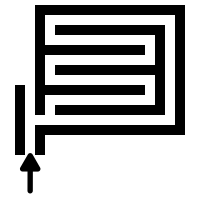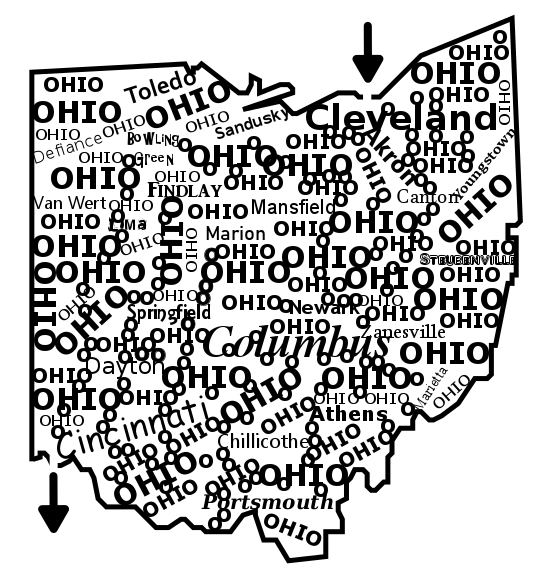Want to know what types of intersections will you find in drawn mazes ? Are you an artist or a maze solver ? Below is a partial list with examples of the types of pathways and junctions that can be made to create a drawn maze using mostly a grid-like pattern. Slight variations of these would exist for non-grid maze creations also, like hand drawn, triangular, hexagonal, etc. Lets’ start with the most simple part of the drawn maze.
I break maze intersections and junctions into 6 categories:
No Choice Pathways
Intersections
Spirals
Loops and Branches
Dead Ends
Special Pathways
Let’s look at each of these categories with details, and examples.
No Choice Pathways:
The Main Path or Main Passageway
Looks like a standard straight line. There are no choices to make other than to continue forward on the path you are on. Not a junction or an intersection really, but what you are on before you get to one and so a great place to begin.
The Left or Right Turn
No choice is available, but the main path turns to the left or right to change the direction of the solver. Not a junction or intersection, just a new direction for the main pathway. Happens countless times in a maze !
The Back and Forth
This stands in for all possibilities of patterns with no choices - and there is an infinite amount ! If you break it down it is just a pathway with many turns and because there are no choices it is in some ways filler. I would define this one as a series of pathways and turns that move the solver back and forth on the pathway without any choice of direction as in a labyrinth. A very common pathway configuration.
Intersections:
The Standard Intersection -
Looks like a plus sign to the solver. At an intersection the solver must decide between turning left, right or continuing to go straight on the current pathway. A standard intersection has 3 choices (4 if you think returning the way you came is a good idea).
The T - intersection -
The main path comes to a junction where the maze solver has two choices and needs to go either left or right. Looks like a T (but can also be a T on its side if you are traveling on the same pathway). The main pathway in this junction ends, so continuing the way you came is not an option. A choice must be made.
The Take or Continue intersection -
The standard and most common choice you will have to make many times in a maze. Looks like a T on it’s side, and can go in any direction as long as the main pathway continues on (this is what sets this intersection apart from the T - intersection above). A decision needs to be made to continue on your path or turn onto another path. Below are versions to turn left or right vs. continuing on the main path.
The Y - intersection -
An angled version of the T intersection that looks like the letter Y. The maze solver must make a similar choice as in the T intersection. Continuing on the main path is not an option.
The Multi-choice intersection-
A maze solver comes to a section where the main pathway splits off into many different directions from the main passageway. Different from a standard intersection in that it can have more than 3 new options. This also has the most different options on how it can look. A maze with Multi-choice options will typically be more difficult to solve. Also, the pathway options may be spaced over a larger area. The example on the right has 7 possible paths close together that can chosen.
The Fork intersection -
A specific type of multi-choice intersection - a pathway that comes to a decision intersection that breaks into 3 - 5 possible choices, all typically pointing in an onward direction, looking similar to a fork.
Spirals:
The Spiral or vortex -
A pathway that spirals into itself and then spirals to exit thru a series of continual left or right turns. Basic spirals do not have any intersections or junctions for the solver to choose. Often used to create a particular look for the maze.
The Multi Spiral Path -
This is a particular type of spiral path that includes additional branches inside the spiral that may be chosen by the solver. Those new pathways eventually lead to dead ends inside the spiral with only one pathway spiraling out (although the 1 spiral out is not a strict rule).
The Spiral Dead End -
A pathway that uses a spiral to trick the solver into a dead end. Instead of a path spiraling in and then spiraling out, you only spiral in to a dead end.
Loops and Branches:
The Return Path or Looping Path -
A pathway that when taken, unknown to the maze solver will return them to the same spot by looping back around, essentially wasting the time of the solver. The pathway might take many turns, but the long term destination loops back around. In the example below the choice of leaving the main path leads to a looping path. Can be used to reduce the difficulty of the maze by replacing some dead ends with looping paths. It will make the maze longer, but more enjoyable when incorrect paths are taken. Instead of reaching dead end the solver loops !
The Side Branch -
A pathway taken off the main pathway that returns to the same main pathway further on in the maze. By taking the side branch the solver continues towards solving but has not taken the simplest path to reach the same point. Different from a looping path in that you do move closer to solving the maze when you take a side branch. Will never look exactly like the example below, but will have the same general structure.
The Optional Side Branch -
Similar to a side branch but involves an obvious choice for the solver. Very common in a Find Items Maze and an Avoid Items Maze where you may need to strategically take the optional side pathway to fulfill a condition of solving the maze (example: maze instructions are to find all the balls and then exit the maze - and a ball is on the optional side branch). While the side branch above is taken unknowingly, this is taken with strategic intention (often because it is obvious).
Dead Ends:
The Dead End -
A pathway that can no longer be traveled on because it has ended. The solver loses and the maze maker wins…I would be surprised if the dead ends you encounter are ever as easy as the example below to see before you reach the end.
The Filler Dead End -
This is a particular type of dead end that is made by a maze maker with the only purpose of filling up space. Often it is unintentional in the greater design of the maze and no maze solver would ever take these mini paths. They truly are filler. A dead end path that no human would ever take.
Special Pathways:
The Weaving Pathway -
Used in Weaving Path Mazes and Pipe Mazes, this path does not dead end when a wall is encountered if the pathway you are on continues directly on the other side of the pathway that it crosses. It is a way of making 3D movement part of a maze that is drawn on a 2D dimension like a piece of paper or computer screen. To help some solvers they can optionally be shown with arrows to indicate movement across pathways (example on the right). These are fun pathways to include in a maze but can be difficult to design without some practice. In fact if you like games where you need to observe mistakes, I wrote a post where you need to find my weaving design mistakes !
The Trail Path -
Used in Hidden Message mazes, Letter mazes and Number mazes. In this pathway movement along the pathway “captures” letters or numbers as you go over them in the pathway. So the solver is not avoiding the letters, but rather collecting them. In the example below from the start the different possible movements create different words, going clockwise: Straight : “THEN” ;Straight, right “THERE” ; Right “THY”; Left, Down “THATS”; Left “THANK YO”.
Random Shaped Pathways -
Most commonly found in mazes that are drawn by hand or that use objects as the walls of the maze. Pathways meander more than normal and have irregular shapes depending on what object is used to make the walls. In the example below how would you define the pathways and intersections ?
I did a 3 part blog series on maze constructions if you want to design your own type of maze. Part 2 speaks about pathway options including weaving pathways !
Part 1 - Starting and Ending a Maze - Speaks to the 9 most popular ways to start and stop a maze
Part 2 - Maze Path options - Explores the 12 different pathway options for a maze
Part 3 - Conditional Path options - Speaks to 11 different conditional options to add to a maze to make it more enjoyable





















